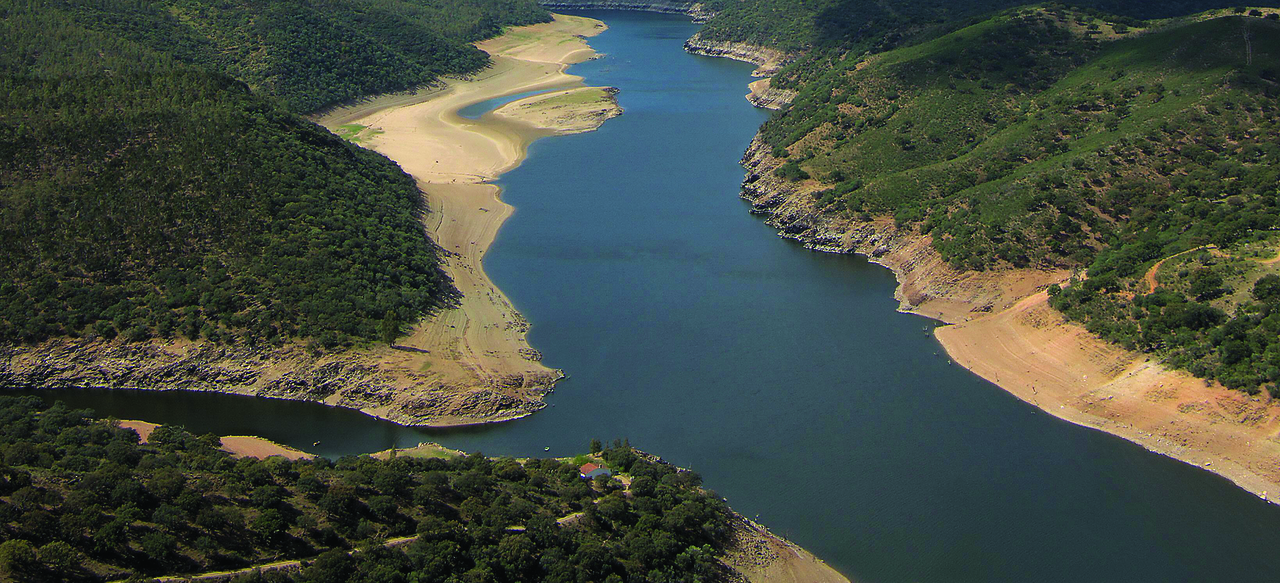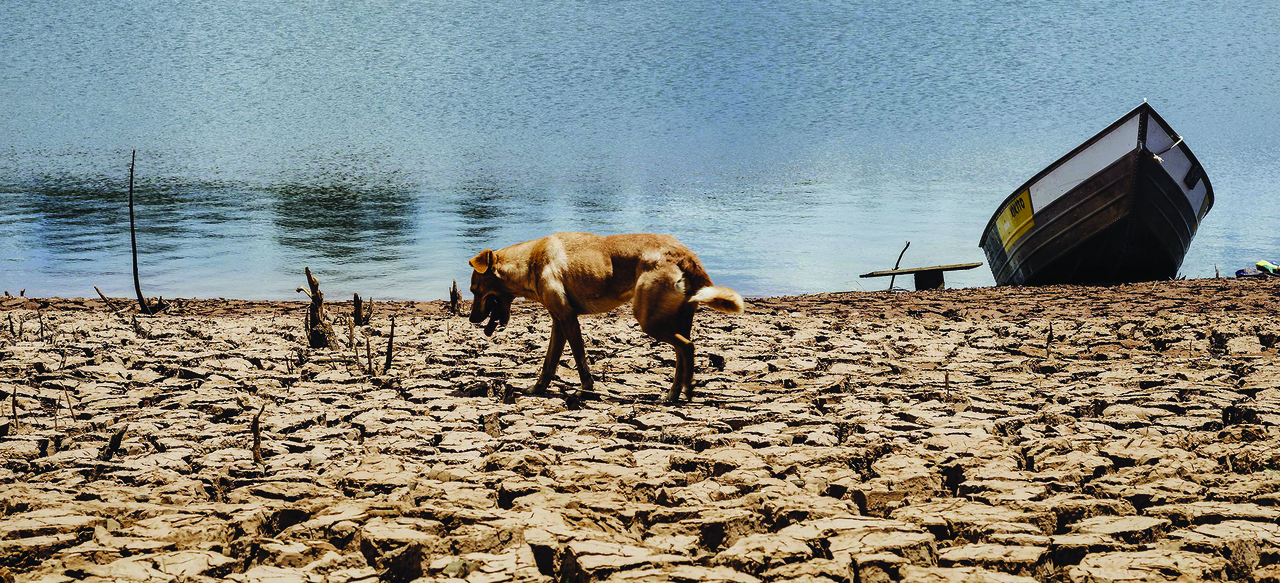When I moved into the countryside, I fulfilled one of my dreams: back to nature; to clean water, to good air, pure earth and self-sufficiency. That was the original plan. I had had enough of cities; of noise, stress, traffic chaos, of concrete, rubbish, bad air, so many people in such a small space. I moved into the mountains near Monchique. It had a spring, the source of a stream, which became a river as it headed for the coast and flowed into the Atlantic. Since I have been sensing nature again with its seasons, I delighted in the water. I started drinking my own water. Having our very own view of water fundamentally sharpened my mindfulness. Because a spring is the reflection and the start of life. It reflects the state of nature.

As a resource, water is based mainly on rain. Where we live, annual rainfall has fallen from between 1,100 and 1,400 mm to between 600 and 700 mm. The amount of rain depends on whether you live on the front part of the mountain (to the south) or behind the mountain (to the north). Some scientists regard global warming as the most important cause of the global shortage of fresh water, and are predicting a drop in the water level of all the world’s rivers and lakes. This means that, in the south of Portugal, we will be living with extreme water shortage. It is clear what that will mean for the economic factors of tourism and agriculture: less is more, sustainable management the only solution. But what does it mean in reality? That is what ECO123 asks Teresa Fernandes, Educational director of the Algarve water company Águas do Algarve SA., on pages 47 to 52
Whoever lives with nature has to take a decision. From the outset it was clear that there would be no pesticides or fungicides or herbicides, and no artificial fertiliser either; instead there would be organic farming for my own consumption. With the water that was available, young trees were planted and watered. At the start, it wasn’t clear how extremely hot and dry it could become. Last year the atmosphere was on average 2.4 degrees Celsius warmer than in normal years. It was the hottest and driest year since 1931. Does another perhaps even hotter summer lie ahead of us now?
In nature you learn to live with the winds. Today, these winds are revealing the meteorological chaos that now prevails. The climate has gradually changed, the winds change direction every day, and have lost their long-term stability; they sometimes cause an extremely hot and dry climate, and sometimes a cold, wet climate. It wasn’t like that two decades ago. There have never been so many muggy days, so many storms before the summer, or so little rain in the winter. Our planet’s atmosphere is warming up. Living conditions are becoming less and less benign. With the right winds, the rain normally comes from a south-westerly direction, from the vast expanse of the Atlantic, says the farmer, say the fishermen. Heavy, saturated clouds release rain over the south of Portugal in the winter. But, nowadays, the wind is increasingly coming from the east, from the mainland and the Mediterranean, and from that wind direction hardly any rain clouds reach us. Using daily temperature measurements and comparing these with the values recorded by IPMA (Instituto Português do Mar e da Atmosfera), in Monchique in 2017, top temperatures of over 40°C in the shade were measured on 32 days between June and October 2017. The last day with abundant rainfall in 2017 was Sunday, 26th March: not in the autumn, but in the spring! The effects of changes in the climate are becoming clear.

Intact mixed forests play a vital role in the protection and cleaning of fresh water. They absorb harmful substances before they reach the rivers and lakes, and provide a varied habitat for many species of fauna.Over the years, have increasingly noticed that one aspect of climate change that should not be ignored is its effect on our fresh water reserves. I noticed that the water in the ground is evaporating more quickly and the maintenance of the fresh water cycle is being jeopardised. Not only has water become more and more important, but there is also less and less water flowing out of the spring. While, at the beginning, the water fed the stream all year round, in the years after the forest fires of 2003, the water started to flow only in the winter after the rains. That was the end of the fish. To collect rainwater, I built tanks at the highest points on the forest plot, in order to make use of the gravitational force of free fall. Tanks should be designed in such a way that the water can flow from the hill down to the valley without the use of pumps. Today, the spring is producing so little water that the stream has been dry since May 2017. Algae often grow in the spring now, which has to be regularly cleaned several times a year. A solar-powered pump keeps the water circulating to minimise the formation of algae, but the really hard times still lie ahead of us.
As most of humanity, and people in Portugal too, are already living in urban centres, in other words in cities, which are planned and constructed in such a way that the responsibility for one’s own well-being is always delegated to someone else and electricity comes out of the socket and water from a tap, a water shortage is only noticed when it’s too late. It is the system that we are already familiar with from industrial farming and from many local authorities. Their own surface water reserves are used up at some stage, the reservoirs are empty, the rivers poisoned. You can also read our interview with Arlindo Marques about paper manufacturing by Celtejo on the Rio Tejo on page 36. So, people start drilling for water and hit an underground aquifer. It is estimated that one-third of the world’s population, i.e. 2.5 billion people in the cities, now depend on underground water for their supply of drinking water. The most populous countries in the world, China and India, get at least half of their water from groundwater. Countries such as Denmark and the Netherlands are almost completely dependent on this source. The problem with extracting groundwater is that you cannot see it. A parish, a farmer or an industrial company doesn’t notice that an aquifer is running out until a borehole dries up all of a sudden.

Our reserves of water are finite. When an aquifer is exhausted, it is not just the groundwater levels that fall; water levels in rivers drop and springs and streams dry up. It depends on how much water is withdrawn from the aquifers. Read our report on this problem, concerning the commercial use of mineral water from Monchique and its export to China and Canada on the next pages.
While humans have been using wells and underground reservoirs for thousands of years, the large-scale extraction of groundwater through boreholes is a phenomenon that only became possible in the 20th century with the spread of electricity and affordable pumps. In many parts of the world, artificial watering using pumps was celebrated as a gift of technical progress to start with, because it enabled cereal crops and vegetables to be cultivated all year round. People hoped for higher yields per hectare of arable land. Monocultures, especially along the Alentejo coast and on the Rio Sado, replaced the previous diversity of crops and are supported by large quantities of pesticides and fertiliser. On this subject, read our report “The Sad River” on pages 26 to 33. In the short term, the yields did increase enormously, but at the expense of the ground and the water balance. But after more than 50 years of industrial agriculture, the so-called Green Revolution has destroyed the diversity of species, contaminated the environment with chemicals and made it dependent on intensive irrigation. Farmers now have to compete for scarce water and pay a high price for it. It is the end of a thousand-year-old custom among famers that water was shared and looked after, and which ensured the traditional cohesion of villages at times of floods and droughts and through caring for the water. Nowadays, we hear constantly of situations where conflicts about water rights have flared up; neighbourhood disputes even resorting to violence are not uncommon.
It is not only Cape Town with its four million inhabitants that has a serious water problem. Mexico City too is being left quite literally almost high and dry. Today, the metropolis of 20 million inhabitants gets 70 percent of its water from aquifers, and it is being extracted 50 percent faster that it is being replenished naturally by rain. About one third of the city’s water has to be pumped up to 2,300 metres above sea level, in some cases from a distance of 300 kilometres. These reserves have been almost used up. In addition, the city has for decades been sinking deeper and deeper into the ground, because the cavities in which the water had collected are empty. This process, which is also familiar in regions where coal is mined and oil extracted, is known as land subsidence. Mexico City was the first city to be affected by this phenomenon as a consequence of water extraction, because it stands on sponge-like, porous subsoil and is sinking 50 centimetres per year. Again and again, new cracks are appearing in concrete bridges and high-rise buildings. Mexico is one of the countries where serious earthquakes are a feature of daily life. And there are many other similar situations. Tokyo, Manila and Dhaka – along with many other metropolises – are slowly sinking.
The water crisis is not confined to major cities and far-off countries. It is becoming tangible in every corner of southern Europe. Waiting, and remaining spellbound like a rabbit caught in the headlights, is no longer a strategy for survival that can be recommended. Hoping and praying for rain? Carrying on as we are will lead to disaster. Because the clock is ticking. Clean water, our common property, which we consume, waste and pollute, has also become a commodity. Rich people can still afford it, but the poor are dying of thirst. Humankind must become aware of the fact that our planet’s water reserves are finite.
Since the origin of our planet, the quantity of water has remained the same. It is more or less the same water that circulates. With every year that passes, however, it is being distributed more unequally. When it is raining less in the south, and the north of Europe is sinking in the floods of rain, we have to draw certain conclusions. We have to deal with water, the basis of our existence, be it in springs or streams or rivers, in aquifers or in lakes, much more responsibly and even more sustainably, again. This will not work on the basis of a market economy. Because every living thing has a right to clean drinking water.
 Eco123 Revista da Economia e Ecologia
Eco123 Revista da Economia e Ecologia

